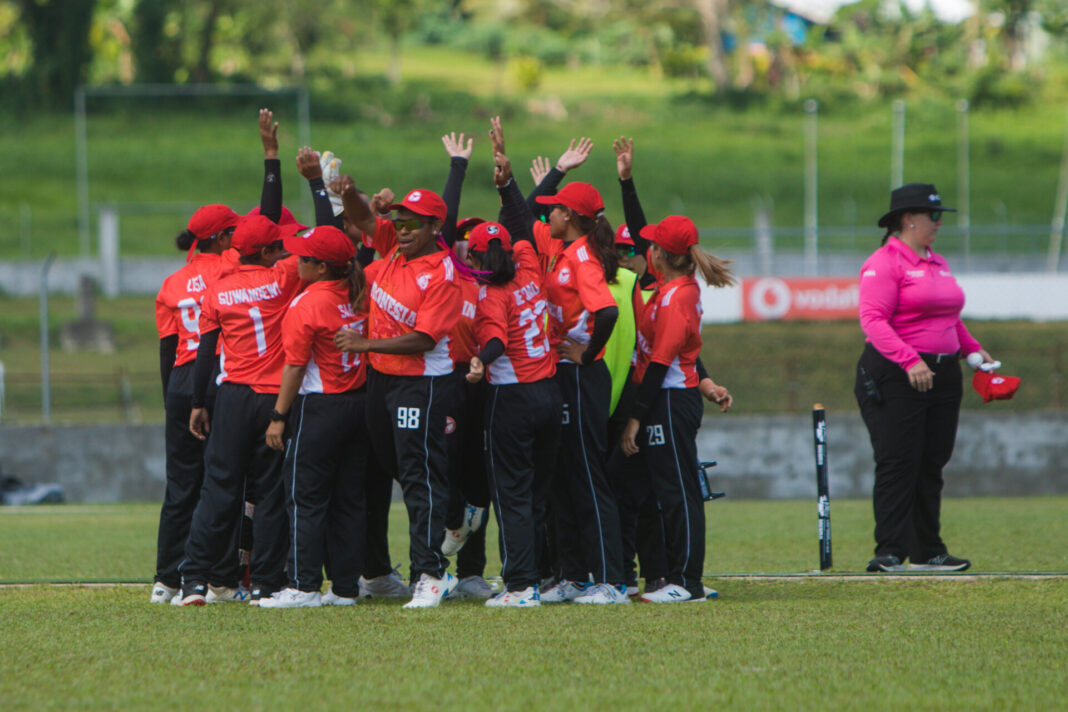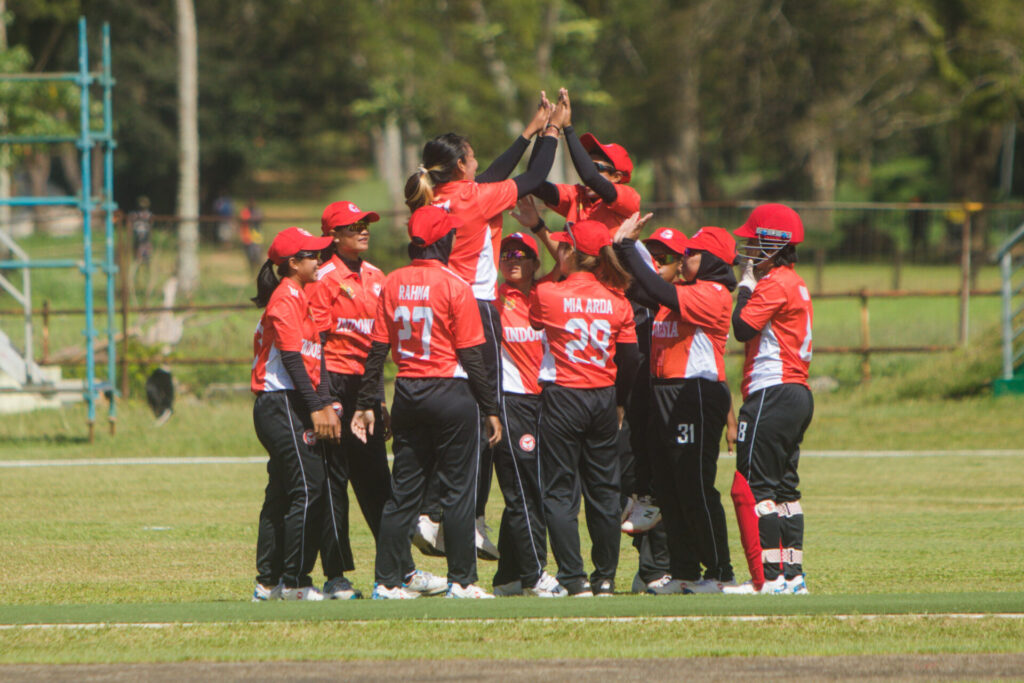Indonesia’s quest to win the East Asia-Pacific Qualifier for the 2024 Women’s T20 World Cup started off with great misfortune, having their connecting flight between Melbourne and host city Port Vila, Vanuatu cancelled. After nearly two days of being stranded in Australia, they finally set foot in Vanuatu two days after their first scheduled match.
Dominant early matches
To make up for lost time, the Indonesians were presented with a revised schedule that involved them playing six matches in four matchdays. This was a daunting task, but the team were keen to get the show on the road – like the travel curveball they had been thrown, they took the condensed fixtures in their stride.
What followed was a resounding showing of how much progress this team has made since their last EAP qualifying tournament in 2019. Indonesia’s first match saw them smash 144 past the Cook Islands, with openers Wesika Ratna Dewi and Nanda Sakarini putting on a 101-run partnership before restricting their opponents to 78/9. This result was followed by emphatic victories over Fiji and Samoa in their first double-header, with Indonesia bowling out both opponents cheaply and racing to their targets without losing a wicket.
These early matches were characterised by expansive strokeplay, with boundaries making up 45% of the runs, while the discipline of the bowling and fielding far outclassed those of Indonesia’s first three opponents. Much lauded for her eventual tally of 113 runs, nine wickets, and three Player of the Match awards, Wesika also led the way in the field where she was involved in three run outs and a catch. Andriani also starred with spectacular figures of 4/15 against the Cook Islands and 3/2 vs Samoa.
Challenging later rounds
The match against Japan initially followed a similar trajectory to the early matches, where Indonesia bowled and fielded tidily to keep Japan to 66, but Japan proved a step up with their own bowling and fielding efforts. The Japanese team constricted the usually proactive Indonesian top-order to 38 off 10.4 overs when Sakarini holed out trying to push the run-rate. It wasn’t until Maria Corazon bludgeoned 25 runs from seven balls that the match was put to bed.
One other event in the Japan game, while not affecting the result, would prove consequential – key all-rounder Andriani injured her finger while diving in the covers. This ended her role in that match and, as it would turn out, the tournament.
At this point, Indonesia, Vanuatu, and pre-tournament favourites PNG emerged as the teams challenging for advancement to the Global Qualifier. Vanuatu had blown the tournament wide open in their opening match, chasing down PNG’s total of 89 with 15 balls to spare. The result of Vanuatu’s match with Indonesia would be crucial, with the winner in the box seat to qualify.
While the difficulties with the bat against Japan loomed large in their batting innings versus Vanuatu, it was Indonesia’s fielding innings that contained many missed opportunities. To begin, fast bowler Putri Suwandewi was uncharacteristically wayward in her three-over opening spell, conceding a boundary in each over. Fellow opening bowler Wesika, having bowled a miserly 3.4 overs, was hit for consecutive fours by Vanuatu’s eventual hero Alvina Chillia. Vanuatu ended up setting 85, but there was the sense that the total could have been significantly lower. Any extra runs eked out proved crucial with Indonesia falling 20 runs short.
Teams are loathed to talk about the impact of missing players, but Andriani’s absence felt crucial. A staple in the middle overs alongside captain Wayan Sariani, Andriani’s spin went at an overall economy rate of 2.63 in her four matches. Her middle-order hitting was also sorely missed – Indonesia’s batting strength had come from having four batters who could hit the boundary regularly, and without her, Vanuatu’s excellent bowling attack found it easier to dictate terms after dismissing Nanda, Wesika and Corazon cheaply.
Despite the loss to Vanuatu, Indonesia entered the final matchday still having a chance at qualifying, needing to beat PNG by a reasonable margin and hoping that Japan does the same to Vanuatu in the concurrent game. For a while, Japan looked like holding up their end of the bargain holding Vanuatu to less than four an over, but the hosts got their act together to win comfortably and secure their historic qualification. Meanwhile, Indonesia looked nowhere near it, consistently making mistakes on their way to conceding 141 before collapsing to 63 trying to chase it down.

Ifs and buts
It was possible that the team felt overawed by the pressure, and in all likelihood, two unplanned double-headers had caught up to them. But Indonesia definitely had a chance, and it’s hard not to look back on the Vanuatu game with a sense of “what if?”. What if they had been more economical in their bowling Powerplay? What if one of their top three batters was able to take the innings deep? And, perhaps most ruefully, what if Andriani hadn’t gone down injured?
Regretful questions like this only ever arise from situations where there were major opportunities. And as it goes with what-ifs, they can go the other way, too. What if Vanuatu’s batters hadn’t been so sloppy when running between wickets? What if Sariani hadn’t won every single toss this tournament? And even if she had been fit, what if Andriani ended up being slogged by Vanuatu and PNG’s batters like her teammates?
Ultimately, while Indonesia didn’t get the qualification berth, the 4-2 win-loss record this year is a vast improvement on their 2-3 tally four years ago. This Indonesian team is still young – not just the ages of their players, but the team itself has only existed since 2016. For comparison, at this stage in their timeline, the now world-beating Thailand team was only just starting to string wins together in regional tournaments.
There is absolutely lots of room for improvement, but there is also so much opportunity going forward.
You’re reading Emerging Cricket — brought to you by a passionate group of volunteers with a vision for cricket to be a truly global sport, and a mission to inspire passion to grow the game.
Be sure to check out our homepage for all the latest news, please subscribe for regular updates, and follow EC on Twitter, Facebook, LinkedIn and YouTube.
Don’t know where to start? Check out our features list, country profiles, and subscribe to our podcast. Support us from US$2 a month — and get exclusive benefits, by becoming an EC Patron.








